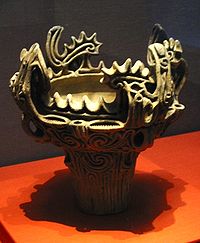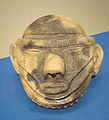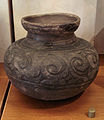- Jōmon period
-
Not to be confused with Jeulmun pottery period.
The Jōmon period (縄文時代 Jōmon jidai) is the time in Japanese prehistory from about 14,000 BC[1][2] to 300 BC.
The term jōmon means "cord-patterned" in Japanese. This refers to the pottery style characteristic of the Jōmon culture, and which has markings made using sticks with cords wrapped around them. Recent Y-DNA haplotype testing has found that the Jōmon are the genetic ancestors of the Ainu and partly of some modern Japanese people.[3]
History of Japan
"Flame-formed earthenware vessel"
(火焔土器)
Middle Jōmon (3000–2000 BC)- Paleolithic 35,000–14,000 BC
- Jōmon period 14,000–300 BC
- Yayoi period 300 BC–250 AD
- Kofun period 250–538
- Asuka period 538–710
- Nara period 710–794
- Heian period 794–1185
- Kamakura period
1185–1333- Kenmu restoration
1333–1336
- Kenmu restoration
- Muromachi period (Ashikaga)
1336–1573- Nanboku-chō period
1336–1392 - Sengoku period
1467–1573
- Nanboku-chō period
- Azuchi–Momoyama period
1568–1603 - Edo period (Tokugawa)
1603–1868 - Meiji period 1868–1912
- Taishō period 1912–1926
- Shōwa period 1926–1989
- Heisei period 1989–present
- Lost Decade
- Empire of Japan (prewar)
1868–1945 (political entity) - Japan (postwar)
1945–present (political entity) - Economic history
-
- History of currency
- Educational history
- Military history
- Naval history
- History of seismicity
Contents
Incipient and initial Jōmon (8,000 – 4000 BC)
The Japanese are considered today to be descended from a mixture of the ancient hunter-gatherer Jōmon culture and the later rice agriculture Yayoi culture. These two major ancestral groups came to Japan over different routes at different times. The Jōmon ancestors were an Ice Age culture that may have come to the Northern and Southern Japanese archipelago around 20,000 BC, when there was an ice bridge connecting Siberia and Northern Japan. The Yayoi people are thought to have arrived about 1000 BC from china
Early pottery
According to archaeological evidence, the Jōmon people created some of the oldest known pottery vessels in the world, known as Jōmon Pottery, dated to the 14th century BC.[4] The antiquity of this pottery was first identified after the Second World War, through radiocarbon dating methods.[5]
Archaeologist Junko Habu claims that "The majority of Japanese scholars believed, and still believe, that pottery production was first invented in mainland Asia and subsequently introduced into the Japanese archipelago," and explains that "A series of excavations in the Amur River Basin in the 1980s and 1990s revealed that pottery in this region may be as old as, if not older than, Fukui Cave pottery".[4]
The Jōmon era pottery was called "Jōmon doki", the first word meaning "rope pattern" and indicating the decoration on most Jōmon earthenware that resembles designs made by rope. The pots were mostly used to eat out of or store food[citation needed]. The Jōmon people also made clay figures and vessels decorated with patterns of a growing sophistication made by impressing the wet clay with braided or unbraided cord and sticks.[4]
Neolithic traits
The manufacturing of pottery typically implies some form of sedentary life due to the fact that pottery is highly breakable and thus generally useless to hunter-gatherers who are constantly on the move. The Jōmon people were therefore probably some of the earliest sedentary or at least semi-sedentary people in the world. They used chipped stone tools, ground stone tools, traps, and bows, and were probably semi-sedentary hunters-gatherers and skillful coastal and deep-water fishermen. They practiced a rudimentary form of agriculture and lived in caves and later in groups of either shallow pit dwellings or above-ground houses, leaving rich middens for modern archaeological study.
Population expansion
This semi-sedentary culture led to important population increases, so that the Jōmon exhibit some of the highest densities known for foraging populations.[6] Genetic mapping studies by Cavalli-Sforza have shown a pattern of genetic expansion from the area of the Sea of Japan towards the rest of eastern Asia. This appears as the third most important genetic movement in Eastern Asia (after the "Great expansion" from the African continent, and a second expansion from the area of Northern Siberia), which suggests geographical expansion during the early Jōmon period.[7] These studies also suggest that the Jōmon demographic expansion may have reached America along a path following the Pacific coast.[8]
Main periods
Incipient Jōmon (14,000 – 7500 BC)
- Linear applique
- Nail impression
- Cord impression
- Muroya lower
Initial Jōmon (7500 – 4000 BC)
- Igusa
- Inaridai
- Mito
- Lower Tado
- Upper Tado
- Shiboguchi
- Kayama
Early to Final Jōmon (4000 – 300 BC)
Reconstructed buildings in the Sannai-Maruyama site, Aomori Prefecture
The Early and Middle Jōmon periods saw an explosion in population, as indicated by the number of settlements from this period. These two periods occurred during the prehistoric Holocene Climatic Optimum (between 4000 BC and 2000 BC), when temperatures reached several degrees Celsius higher than the present, and mean sea level was higher by 5 to 6 metres.[9] Beautiful artistic realisations, such as highly decorated "flamed" vessels, remain from that time. After 1500 BC, the climate cooled, and populations seem to have contracted dramatically. Comparatively few archaeological sites can be found after 1500 BC.
The Early Jōmon is the first stage in the Jomon era of Japanese pre-history. The Jomon period itself ranged from 10,000 to 300 BC, with the first stage lasting from 4000 to 3000 BC. The Early Jomon is characterized by the high sea level (2 to 3 meters higher than the modern day) and a significant population increase.[10] This period saw a rise in complexity in the design of pit houses, the most commonly used method of housing at the time.[11]
The Late Jōmon covered the period of history from around 2000 to 1000 BC, while the Final Jōmon spanned from around 1000 to 300 BC.
By the end of the Jōmon period, a slow shift had taken place according to archaeological studies. New arrivals from the continent seem to have invaded Japan from the West, bringing with them new technologies such as rice farming and metallurgy. The settlements of the new arrivals seem to have coexisted with those of the Jōmon for some time. Under these influences, the incipient cultivation of the Jōmon evolved into sophisticated rice-paddy farming. Many other elements of Japanese culture also may date from this period and reflect a mingled migration from the northern Asian continent and the southern Pacific areas. Among these elements are Shinto religion, marriage customs, architectural styles, and technological developments such as lacquerware, textiles, laminated bows, metalworking, and glass making. The Jōmon is succeeded by the Yayoi period outside Hokkaido, where the Jōmon is succeeded by the Zoku-Jōmon (post-Jōmon) period. The Zoku-Jōmon culture is succeeded by the Satsumon culture around the 7th century.
Main periods
- Middle Jōmon (3000–2000 BC):
-
- Katsusaka/Otamadai,
- Kasori E1,
- Kasori E2.
- Late Jōmon (2000–1000 BC):
-
- Horinouchi,
-
- Kasori B2,
- Angyo 1
- Final Jōmon (1000–300 BC):
-
- Tohoku District
- Kanto District
-
Late Jomon clay statue, Kazahari I, Aomori Prefecture, 1500–1000 BC.
-
Late Jomon clay head, Shidanai, Iwate Prefecture, 1500–1000 BC.
-
A Final Jōmon statuette called dogū (土偶 "earthenware figure") (1000–300 BC), Tokyo National Museum, Japan.
See also
- Unofficial nengō system (私年号)
- Jeulmun pottery
- Jōmon Era count
- Jōmon pottery
- Ainu people
- Ko-shinto (Jomon-jin)
- Xu Fu
Notes
- ^ Jomon Fantasy: Resketching Japan's Prehistory. June 22, 1999.
- ^ "Ancient Jomon of Japan", Habu Junko, Cambridge Press, 2004[dead link]
- ^ Nakahori, Yutaka (2005). Y染色体からみた日本人 (Y Senshokutai kara Mita Nihonjin). Iwanami Science Library. ISBN 978-4000074506.
- ^ a b c Habu, Junko (2004). Ancient Jomon of Japan. Cambridge University Press. ISBN 78-0521776707.
- ^ Radiocarbon measures of carbonized material from pottery artifacts (uncalibrated): Fukui Cave 12500 +/-350 BP and 12500 +/-500 BP (Kamaki&Serizawa 1967), Kamikuroiwa rockshelter 12, 165 +/-350 years BP in Shikoku (Esaka et al. 1967), from "Prehistoric Japan", Keiji Imamura, p46
- ^ "Jōmon population densities are among the highest recorded for a foraging population, although in some areas of the Pacific Coast of North America, comparable and even higher figures of population densities have been observed (Hassan, 1975)." The History and Geography of Human Genes p249, Cavalli-Sforza ISBN 0-691-08750-4.
- ^ "The third synthetic map shows a peak in Japan, with rapidly falling concentric gradients... Taken at face value, one would assume a center of demographic expansion in an area located around the Sea of Japan." The History and Geography of Human Genes p249, Cavalli-Sforza ISBN 0-691-08750-4.
- ^ "The synthetic maps suggest a previously unsuspected center of expansion from the Sea of Japan but cannot indicate dates. This development could be tied to the Jōmon period, but one cannot entirely exclude the pre-Jōmon period and that it might be responsible for a migration to the Americas. A major source of food in those pre-agricultural times came from fishing, then as now, and this would have limited for ecological reasons the area of expansion to the coastline, perhaps that of the Sea of Japan, but also farther along the Pacific Coast." The History and Geography of Human Genes p253, Cavalli-Sforza ISBN 0-691-08750-4.
- ^ "Prehistoric Japan", Imamura
- ^ Nbz.or.jp's Early Jomon Retrieved January 2007
- ^ Early Jomon hamlet found Retrieved January 2007
References
- Aikens, C. Melvin, and Takayasu Higuchi. (1982). Prehistory of Japan. Studies in Archaeology. New York: Academic Press. (main text 337 pages; Jomon text 92 pages)
- Habu, Junko, Ancient Jomon of Japan, Cambridge University Press, 2004, ISBN 0-521-77213-3
- Habu, Junko, "Subsistence-Settlement systems in intersite variability in the Moroiso Phase of the Early Jomon Period of Japan"
- Imamura, Keiji, Prehistoric Japan, University of Hawai Press, 1996, ISBN 0-8248-1852-0
- Kobayashi, Tatsuo. (2004). Jomon Reflections: Forager Life and Culture in the Prehistoric Japanese Archipelago. Ed. Simon Kaner with Oki Nakamura. Oxford, England: Oxbow Books. (main text 186 pages, all on Jomon)
- Koyama, Shuzo, and David Hurst Thomas (eds.). (1979). Affluent Foragers: Pacific Coasts East and West. Senri Ethnological Studies No. 9. Osaka: National Museum of Ethnology. (main text 295 pages; Jomon text [3 good articles] 72 pages)
- Michael, Henry N., The Neolithic Age in Eastern Siberia. Henry N. Michael. Transactions of the American Philosophical Society, New Ser., Vol. 48, No. 2 (1958), pp. 1–108. (laminated bow from Korekawa, Aomori)
- Pearson, Richard J., Gina Lee Barnes, and Karl L. Hutterer (eds.). (1986). Windows on the Japanese Past: Studies in Archaeology and Prehistory. Ann Arbor, Michigan: Center for Japanese Studies, The University of Michigan. (main text 496 pages; Jomon text 92 pages)
- Temple DH. 2007. Stress and dietary variation among prehistoric Jomon foragers. American Journal of Physical Anthropology 133: 1035-1046.
- Temple DH. 2008. What can stature variation reveal about environmental differences between prehistoric Jomon foragers? Understanding the impact of developmental stress on environmental stability. American Journal of Human Biology 20:431-439.
External links
- BBC audio file (15 minutes). Discussion of Jomon pots. A History of the World in 100 Objects.
- Memory of the Jomon Period by The University Museum, The University of Tokyo
- The Prehistoric Archaeology of Japan by the Niigata Prefectural Museum of History
- Chronologies of the Jomon Period
- Jomon Culture by Professor Charles T Keally
- Yayoi Culture by Professor Charles T Keally
Categories:- Ancient peoples
- Ainu
- Japanese pottery
- Jōmon period
- Archaeological cultures
Wikimedia Foundation. 2010.










